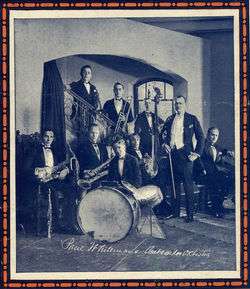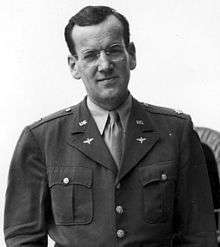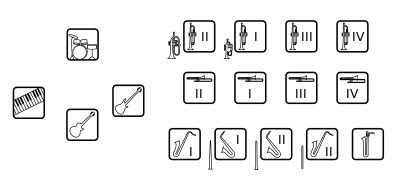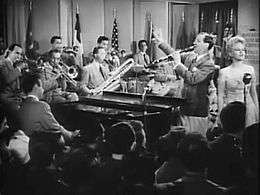Big band
| Big band | |
|---|---|
| Stylistic origins | Jazz |
| Cultural origins | 1920s: US |
| Typical instruments | |
| Derivative forms | |
| Subgenres | |
A big band is a type of musical ensemble associated with playing jazz music and which became popular during the Swing Era from the early 1930s until the late 1940s. Big Bands evolved with the times and continue to today. A big band typically consists of approximately 12 to 25 musicians and contains saxophones, trumpets, trombones, and a rhythm section. The terms jazz band, jazz ensemble, stage band, jazz orchestra, and dance band are also used to refer to this type of ensemble. This does not, however, mean that each one of these names is technically correct for naming a "big band" specifically.
In contrast to smaller jazz combos, in which most of the music is improvised, or created spontaneously, music played by big bands is highly "arranged", or prepared in advance and notated on sheet music. The music is traditionally called 'charts'. Improvised solos may be played only when called for by the arranger.
History and style
There are two distinct periods in the history of popular bands. Beginning in the mid-1920s, big bands, then typically consisting of 10–25 pieces, came to dominate popular music. At that time they usually played a form of jazz that involved very little improvisation, which included a string section with violins, which was dropped after the introduction of swing in 1935. A few bands also had violas and cellos, usually one or two along with them. The dance form of jazz was characterized by a sweet and romantic melody. Orchestras tended to stick to the melody as it was written and vocals would be sung (often in a tenor voice) and in tune with the melody.
Typical of the genre were such popular artists as Paul Whiteman, Ted Lewis, Harry Reser, Leo Reisman, Abe Lyman, Nat Shilkret, George Olsen, Ben Bernie, Bob Haring, Ben Selvin, Earl Burnett, Gus Arnheim, Henry Halstead, Rudy Vallee, Jean Goldkette, Isham Jones, Roger Wolfe Kahn, Sam Lanin, Vincent Lopez, Ben Pollack, Shep Fields and Fred Waring.

Many of these artists changed styles or retired after the introduction of swing music. Although unashamedly commercial, these bands often featured front-rank jazz musicians - for example Paul Whiteman employed Bix Beiderbecke and Frankie Trumbauer. There were also "all-girl" bands such as "Helen Lewis and Her All-Girl Jazz Syncopators". Lewis and her band, Ben Bernie's band "Ben Bernie and All the Lads", and Roger Wolfe Kahn's band were filmed by Lee De Forest in his Phonofilm sound-on-film process in 1925, in three short films which are now in the Library of Congress film collection.
Towards the end of the 1920s, a new form of Big Band emerged which was more authentically "jazz," in that more space was given to improvised soloing. This form of music never gained the popularity of the sweet dance form of jazz. The few recordings made in this form of jazz were labelled race records and were intended for a limited urban audience. Few white musicians were familiar with this music, Johnny Mercer and Hoagy Carmichael being notable exceptions. The three major centres in this development were New York City, Chicago and Kansas City. In the former, a sophisticated approach to arranging predominated, first in the work of Don Redman for the Fletcher Henderson band, later in the work of Duke Ellington for his Cotton Club orchestra, and Walter 'Foots' Thomas for Cab Calloway's. Some big ensembles, like the Joe "King" Oliver outfit played a kind of half arranged, half improvised jazz, often relying on "head" arrangements. Other great bands, like the one of Luis Russell became a vehicle for star instrumentalists, in his case Louis Armstrong. There the whole arrangement had to promote all the possibilities of the star, although they often contained very good musicians, like Henry "Red" Allen, J. C. Higginbotham and Charley Holmes.
Radio and movies
Earl Hines became the star of Chicago with his Grand Terrace Cafe band and began to broadcast live from The Grand Terrace nightly coast-to-coast across America. Meanwhile, in Kansas City and across the Southwest, an earthier, bluesier style was developed by such bandleaders as Benny Moten and, later, by Jay McShann and Jesse Stone. Big band remotes on the major radio networks spread the music from ballrooms and clubs across the country during the 1930s and 1940s, with remote broadcasts from jazz clubs continuing into the 1950s on NBC's Monitor. Radio was a major factor in gaining notice and fame for Benny Goodman, the "Pied Piper of Swing". Soon, others challenged him, and "the battles of the bands" became a staple at theater performances featuring many groups on one bill.
Gloria Parker, Princess of the Marimba, conducted the 21-piece Swingphony whose performances were broadcast nationally from the Kelly Lyceum Ballroom in Buffalo, New York. This was the largest big band ever led by a female bandleader.
Big Bands also began to appear in movies in the 1930s right on through to the 1960s, though the cameos by bandleaders were often stiff and incidental to the plot. Fictionalized biographical films of Glenn Miller, Gene Krupa, Benny Goodman, and others were made in the 1950s, as nostalgic tributes to the glory years.
Rise and fall of swing
Swing music began appearing in the early 1930s, distinguished by a more supple feel than the more literal 4/4 of earlier jazz and a walking bass - Walter Page is often credited with developing this, though isolated earlier examples exist (e.g. by Wellman Braud on Ellington's Washington Wabble from 1927).
This type of music flourished through the early 1930s, although there was little mass audience for it until around 1936. Up until that time, it was viewed with ridicule and looked upon as a curiosity. After 1935, big bands rose to prominence playing Swing music and held a major role in defining swing as a distinctive style. Western swing musicians also formed very popular big bands during the same period..
There was a considerable range of styles among the hundreds of popular bands. Many of the better known bands reflected the individuality of the bandleader, the lead arranger, and the personnel. Count Basie played a relaxed propulsive swing, Bob Crosby more of a dixieland style, Benny Goodman a hard driving swing, and Duke Ellington’s compositions were varied and sophisticated. Many bands featured strong instrumentalists, whose sounds dominated, such as the clarinets of Benny Goodman and Artie Shaw, the trombone of Jack Teagarden, the trumpet of Harry James, the drums of Gene Krupa, and the vibes of Lionel Hampton. The popularity of many of the major bands was amplified by star vocalists, such as Frank Sinatra with Tommy Dorsey, Helen O’Connell and Bob Eberly with Jimmy Dorsey, Ella Fitzgerald with Chick Webb, Billie Holiday and Jimmie Rushing with Count Basie, Dick Haymes and Helen Forrest with Harry James, Doris Day with Les Brown, and Peggy Lee with Benny Goodman. Some bands were "society bands" which relied on strong ensembles but little on soloists or vocalists, such as the bands of Guy Lombardo and Paul Whiteman.
By this time the Big Band was such a dominant force in jazz that the older generation found they either had to adapt to it or simply retire - with no market for small-group recordings (made worse by a Depression-era industry reluctant to take risks), some musicians such as Louis Armstrong and Earl Hines fronted their own bands, while others, like Jelly Roll Morton and King Oliver, lapsed into obscurity.
The major "black" bands of the 1930s included, apart from Ellington's, Hines' and Calloway's, those of Jimmie Lunceford, Chick Webb, and Count Basie. Ironically, the "white" bands of Benny Goodman, Artie Shaw, Tommy Dorsey, Shep Fields and, later, Glenn Miller far eclipsed their "black" inspirations in terms of popularity from the middle of the decade. Bridging the gap to white audiences in the mid-1930s was the Casa Loma Orchestra and Benny Goodman’s early band.

White teenagers and young adults were the principal fans of the Big Bands in the late 1930s and early 1940s. They danced to recordings and the radio, and attended live concerts whenever they could. They were knowledgeable and often biased toward their favorite bands and songs, and sometimes worshipful of the famous soloists and vocalists. Many bands toured the country in grueling one-night stands to reach out to their fans. Traveling conditions and lodging were often difficult, in part due to segregation in most parts of the United States, and the personnel often had to perform on little sleep and food. Apart from the star soloists, many personnel received low wages and would abandon the tour and go home if bookings fell through. Personal problems and intra-band discord could affect the playing of the group. Drinking and addictions were common. Turnover was frequent in many bands, and top soloists were often lured away to better contracts. Sometimes bandstands were too small, public address systems inadequate, pianos out of tune. Successful bandleaders dealt with all these hazards of touring to hold their bands together—some with rigid discipline (Glenn Miller), some with canny psychology (Duke Ellington).
Big Bands played a major role in lifting morale during World War II. Many band members served in the military and toured with USO troupes at the front, with Glenn Miller losing his life while traveling between troop shows. Many bands suffered from the loss of personnel and quality declined at home during the war years. An ill-timed recording strike in 1942 worsened the situation. Vocalists began to strike out on their own and by the end of the war, swing was giving way to less danceable music including bebop. Many of the great swing bands broke up, as the times and tastes changed.
Since 1945
As jazz evolved and expanded in new directions, major band performances of note did occur from the 1950s to the 1970s. Noteworthy performers included: Dizzy Gillespie, Gene Krupa, Buddy Rich, Gil Evans, Johnny Richards, Sun Ra, Gary MacFarland, Charles Mingus, Oliver Nelson, Carla Bley, Thad Jones/Mel Lewis Big Band, Sam Rivers, Don Ellis, Toshiko Akiyoshi – Lew Tabackin Big Band. Lincoln Center Jazz Orchestra and Anthony Braxton.
Later bandleaders pioneered the performance of various Brazilian and Afro-Cuban styles with the traditional big band instrumentation, and big bands led by arranger Gil Evans, saxophonist John Coltrane (on the album Ascension from 1965) and electric bassist Jaco Pastorius introduced cool jazz, free jazz and jazz fusion, respectively, to the big band domain. Modern big bands can be found playing all styles of jazz music. Some large contemporary European jazz ensembles play mostly avant-garde jazz using the instrumentation of the big bands. Examples include the Vienna Art Orchestra, founded in 1977, and the Italian Instabile Orchestra, active in the 1990s. In the late 1990s, swing made a comeback in the US. The Lindy Hop has taken hold on both coasts, and many younger people took an interest in big band styles again.
African "Afrobeat" big bands have existed from 1970 to the present when Fela Kuti of Nigeria, fused big band jazz with Yoruba tribal rhythms, highlife, and American James Brown soul music. As of 2008 there are over 40 working afrobeat big bands including Antibalas, Chicago Afrobeat Project, Chopteeth, Femi Kuti, and Seun Kuti.
Instrumentation

In the second half of the twentieth century, a standard 17-piece instrumentation evolved, for which many commercial arrangements are available. This instrumentation consists of five saxophones (most often two altos, two tenors, and one baritone), four trumpets, four trombones (including one bass trombone) and a four-piece rhythm section (composed of drums, bass, piano, and guitar).
However, variants to this instrumentation are common. Composers, arrangers, and bandleaders have used sections with more or fewer players, and additional instruments, such as vibes, valve trombone, baritone horn\euphonium, bass clarinet, French horn, tuba, banjo, and string section (violin, viola, cello). Accordions are also sometimes used. Male and female vocalists have also joined big bands to perform particular arrangements.
Some arrangements call for saxophone players to double on other woodwind instruments, such as flute or clarinet. Trumpet and trombone players are sometimes called upon to use various sound-changing mutes, and trumpet players sometimes need to play flugelhorn. In some rhythm sections, a guitar player is omitted. Players in the rhythm section may be called upon to play acoustic or electric instruments. Latin or other auxiliary percussion instruments may be added.
Big band arrangements

Typical big band arrangements of the swing period are written in strophic form with the same phrase and chord structure repeated several times. Each iteration, or chorus, most commonly follows Twelve bar blues form or Thirty-two-bar (AABA) song form. The first chorus of an arrangement typically introduces the melody, and is followed by subsequent choruses of development. This development may take the form of improvised solos, written soli sections, and shout choruses.
An arrangement's first chorus is sometimes preceded by an introduction, which may be as short as a few measures or may extend to chorus of its own. Many arrangements contain an interlude, often similar in content to the introduction, inserted between some or all choruses. Other methods of embellishing the form include modulations and cadential extensions.
See also
- List of big bands
- Swing (jazz performance style), a term of praise for playing that has a strong rhythmic "groove" or drive
References
- William Russo, Composing for the Jazz Orchestra University of Chicago Press, Library of Congress no. 61-8642
- George T. Simon, The Big Bands, The Macmillan Company, New York, 1967, Library of Congress no. 67-26643
External links
- State University of New York, Fredonia. Rockefeller Arts Center. Jazz Big Band Arrangements
- Christopher Popa's Big Band Library
- (blog) The Palomar: Remembering the big bands, the Swing Era....
